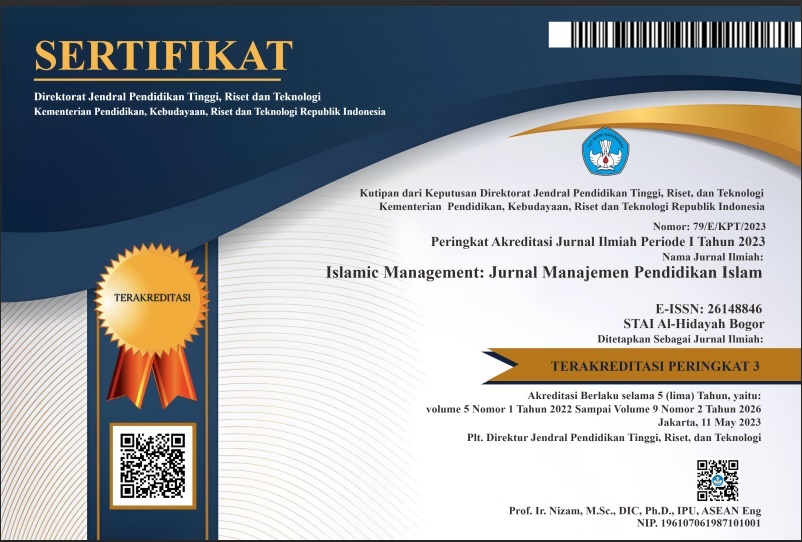WOMEN'S LEADERSHIP IN AISYIYAH ORGANIZATIONS
(Study on Implementation and Challenges at The Regional Level)
DOI:
https://doi.org/10.30868/im.v8i01.8419Keywords:
Gender Challenges, Religious Organizations, Women’s Empowerment, Women’s LeadershipAbstract
This study analyzes the implementation and challenges of women's leadership in Aisyiyah organizations at the regional level, especially in Sukabumi Regency. The background of this study is based on the importance of women's leadership in religious organizations that still face gender stereotypes. Using a quantitative-descriptive approach, data were collected through questionnaires and interviews with 20 leaders and 100 members of Aisyiyah. The results of the study show that women's leadership is considered adequate and has a positive impact on the success of the program. However, challenges such as limited resources and cultural barriers are still felt. Leaders use collaborative strategies, training, and participatory approaches to address them. These findings confirm the importance of leadership training and structural support to optimize women's contributions in religious organizations.
References
Al-Naqbi, S. A., & Aderibigbe, S. A. (2024). Advancing Women’s Leadership in United Arab Emirates Higher Education: Perspectives from Emirati Women. Education Sciences, 14(9), 14091002. https://doi.org/10.3390/educsci14091002
Alameeri, K., Alshurideh, M., & Al Kurdi, B. (2023). Factors and Challenges Influencing Women's Leadership in Management: A Systematic Review. Studies in Computational Intelligence, 1056, 1487–1502. https://doi.org/10.1007/978-3-031-12382-5_82
Arifi, A., & Fathurrohman, R. (2023). The Role of Women’s Leadership in the Traditional Muslim Religious Movement (New Paradigm in PBNU Leadership 2022-2027). PALASTREN: Jurnal Studi Gender, 16(1), 59. https://doi.org/10.21043/palastren.v16i1.18622
Berg, K. T., & Miller, K. E. (2023). Leading the Charge: Female Leaders Advance DEI Initiatives through Employee Empowerment. Journal of Public Relations Research, 35(5–6), 339–356. https://doi.org/10.1080/1062726X.2023.2227302
Bhattacharya, S., Perera, G. A. L. R., Ali, M., Prasad, R., Palika, Begum, S. A., Lhamo, P., Jha, L., & Thomas, M. S. (2024). Leadership and Gender Equality in the Energy Industry. 2024 IEEE 3rd International Conference on Electrical Power and Energy Systems, ICEPES 2024, 1–6. https://doi.org/10.1109/icepes60647.2024.10653623
Brody, C., de Hoop, T., Vojtkova, M., Warnock, R., Dunbar, M., Murthy, P., & Dworkin, S. L. (2015). Economic Self‐Help Group Programs for Improving Women’s Empowerment: A Systematic Review. Campbell Systematic Reviews, 11(1), 1–182. https://doi.org/10.4073/csr.2015.19
Brue, K. L. (2018). Harmony and Help: Recognizing the Impact of Work-Life Balance for Women Leaders. Journal of Leadership Education, 17(4), 219–243. https://doi.org/10.12806/v17/i4/c2
Creswell, J. W., & Clark, V. L. P. (2017). Designing and Conducting Mixed Methods Research (3th ed.). SAGE Publications Ltd.
Cunha, M. J., & Lúcio Martins, R. (2023). Female journalists who have reached the top: perceptions on communication, leadership, and gender bias in the Portuguese press. Corporate Communications, 28(7), 84–100. https://doi.org/10.1108/CCIJ-01-2023-0004
Dhania, D. R., & Rahma, M. Y. (2023). Women Leaders in Indonesia: Career Journey, Challenges, and Needs. ICoP, 1(1), 278–289. https://prosiding.umk.ac.id/index.php/ICoP/article/view/47
Eagly, A. H., & Heilman, M. E. (2016). Gender and leadership: Introduction to the special issue. Leadership Quarterly, 27(3), 349–353. https://doi.org/10.1016/j.leaqua.2016.04.002
Eger, C., Fetzer, T., Peck, J., & Alodayni, S. (2022). Organizational, economic, or cultural? Firm-side barriers to employing women in Saudi Arabia. World Development, 160, 106058. https://doi.org/https://doi.org/10.1016/j.worlddev.2022.106058
Elkhwesky, Z., Salem, I. E., & El Manzani, Y. (2025). Talented women for senior positions across multi-regions: challenges, strategies, and future research agenda. Management Review Quarterly, 75(1), 353–389. https://doi.org/10.1007/s11301-023-00383-z
Emma, L. (2025). Policy Interventions to Promote Gender Equality in Education and Workforce Leadership. January.
Erikson, J., & Josefsson, C. (2023). Feminine Leadership Ideals and Masculine Practices: Exploring Gendered Leadership Conditions in the Swedish Parliament. Politics and Gender, 19(4), 1061–1086. https://doi.org/10.1017/S1743923X23000090
Etikan, I. (2016). Comparison of Convenience Sampling and Purposive Sampling. American Journal of Theoretical and Applied Statistics, 5(1), 1. https://doi.org/10.11648/j.ajtas.20160501.11
Fatimah, F. (2018). Meningkatkan Kemampuan Anggota ’Aisyiyah dalam Pemberdayaan Potensi Ekonomi Daerah untuk Muhammadiyah di Balung Jember. Jurnal Pengabdian IPTEKS, 4(1), 65–76.
Hansch, J., & Janning-Backfisch, N. (2024). Women Leaders in Male-Dominated Industries. Sociology, Work, and Organisations: A Global Context, 133–146. https://doi.org/10.4324/9781003314769-12
Haris, I. A & Maulana, O. (2021). Peranan Organisasi Aisyiyah Dalam Pemberdayaan Perempuan Di Lampung Selatan. An Nida: Jurnal An Nur, 1(1), 18–25.
Hasanah, R. A. N., Harianto, K., & Sutapa, H. (2025). The Effect of Income and Impulsive Buying on Gen Z Investment Decisions in Kediri City with Self-Control as a Moderating Variable. Ekonomis : Journal of Economics and Business, 9(1), 173–181. https://doi.org/10.33087/ekonomis.v9i1.2196
Kilonzo, S. M., Chitando, E., & Tarusarira, J. (2023). The Palgrave Handbook of Religion, Peacebuilding, and Development in Africa. The Palgrave Handbook of Religion, Peacebuilding, and Development in Africa, 1–832. https://doi.org/10.1007/978-3-031-36829-5
Meng, J., & Neill, M. S. (2021). Inclusive leadership and women in public relations: defining the meaning, functions, and relationships. Journal of Public Relations Research, 33(3), 150–167. https://doi.org/10.1080/1062726X.2021.2010556
Munawaroh, A., Septiani, N. M., & Asriadi, A. (2024). Peran Organisasi Aisyiyah Dalam Meningkatkan Pengamalan Pendidikan Islam Indonesia. Masterpiece: Journal of Islamic Studies and Social Sciences, 2(2), 78–88. https://doi.org/10.62083/ck2ak663
Northouse, P. G. (2018). Leadership: Theory and Practice (eighth). SAGE Publications Inc.
Ospina, S. M., & Foldy, E. G. (2020). Global Encyclopedia of Public Administration, Public Policy, and Governance. Global Encyclopedia of Public Administration, Public Policy, and Governance, 1–6. https://doi.org/10.1007/978-3-319-31816-5
Pangestuti, M. W., & Sari, R. M. (2025). Pengaruh Kepemimpinan Transformasional dan Motivasi Kerja terhadap Kinerja Personel TNI AD di Pusat Pendidikan Artileri Medan. Ekonomis : Journal of Economics and Business, 9(1), 191–197. https://doi.org/10.33087/ekonomis.v9i1.2297
Pogrebna, G., Angelopoulos, S., Motsi-Omoijiade, I., Kharlamov, A., & Tkachenko, N. (2024). The impact of intersectional racial and gender biases on minority female leadership over two centuries. Scientific Reports, 14(1), 1–16. https://doi.org/10.1038/s41598-023-50392-x
Sari, A. L., Irwandi, I., Rochmansjah, H. R., Nurdiansyah, I., & Aslam, D. F. (2021). UMKM, Kesetaraan Gender dan Pemberdayaan Perempuan di Indonesia. Jurnal Ekonomi Dan Statistik Indonesia, 1(1), 22–32. https://doi.org/10.11594/jesi.01.01.03
Serafimova, V., Dissanayake, H., & Vasilev, V. (2025). Inclusive Leadership and Corporate Social Responsibility for Women’s Empowerment : From Good Ideas to Sustainable Solution (Issue March). https://doi.org/10.4018/979-8-3693-8694-1.ch009
Sharr, Z. M. (2024). Exploring globally responsible women leadership in Myanmar: characteristics, challenges, and opportunities. Journal of Global Responsibility, 15(4), 327–343. https://doi.org/10.1108/JGR-07-2023-0115
Sheerin, C., & Garavan, T. (2022). Female leaders as ‘Superwomen’: Post-global financial crisis media framing of women and leadership in investment banking in UK print media 2014–2016. Critical Perspectives on Accounting, 86, 102307. https://doi.org/https://doi.org/10.1016/j.cpa.2021.102307
Siwiyanti, L., Amal, M. K., & Sudarma, A. (2022). The Effect Of Leadership Effectiveness On Organizational Performance. International Journal of Management and Business Applied, 1(2), 95–102. https://doi.org/10.54099/ijmba.v1i2.264
Siwiyanti, L., & Senen, S. H. (2023). Literature Dynamics Leadership Development: Bibliometric Analysis to Identify Research Trends. West Science Business and Management, 1(05), 521–531. https://doi.org/10.58812/wsbm.v1i05.431
Siwiyanti, L., & Suyaman, P. (2014). Potret Muhammadiyah dan Aisyiyah Sukabumi. CV. Nurani.
Suban, A., Siwiyanti, L., & Megawati, L. (2023). Developing Competency of Superior Human Resources as a Strategy for Bank Syariah Indonesia (BSI) in Facing the Era of Society 5.0. Hong Kong Journal of Social Sciences, 60(No. 60 Autumn/Winter 2022). https://doi.org/10.55463/hkjss.issn.1021-3619.60.22
Tlaiss, H. A. (2014). Women’s entrepreneurship, barriers and culture: Insights from the United Arab Emirates. Journal of Entrepreneurship, 23(2), 289–320. https://doi.org/10.1177/0971355714535307
Turley, A. M., Ryan, M., & Doyle, E. (2024). Exploring female entrepreneurship experience of Ireland’s business ecosystem: implications for business support. Journal of Entrepreneurship and Public Policy. https://doi.org/10.1108/JEPP-03-2024-0036
Wetzel, A. P. (2010). Internet, mail, and mixed-mode surveys: The tailored design method *. Journal of Continuing Education in the Health Professions, 30(3), 206. https://doi.org/10.1002/chp.20083
Wild, C. E. K., Wells, H., Coetzee, N., Grant, C. C., Sullivan, T. A., Derraik, J. G. B., & Anderson, Y. C. (2023). End-user acceptability of personal protective equipment disinfection for potential reuse: a survey of health-care workers in Aotearoa New Zealand. The Lancet Planetary Health, 7(2), e118–e127. https://doi.org/10.1016/S2542-5196(22)00333-3
World Economic Forum. (2023). Global Gender Gap Report 2023. In the World Economic Forum (June issue). https://www3.weforum.org/docs/WEF_GGGR_2023.pdf
Downloads
Published
How to Cite
Issue
Section
Citation Check
License
Copyright (c) 2025 Leonita Siwiyanti, Kokom Komariah, Asep Muhamad Ramdan

This work is licensed under a Creative Commons Attribution-ShareAlike 4.0 International License.
Authors who publish with this journal agree to the following terms:
- Authors retain copyright and grant the journal right of first publication with the work simultaneously licensed under a Creative Commons Attribution License that allows others to share the work with an acknowledgment of the work's authorship and initial publication in this journal.
- Authors are able to enter into separate, additional contractual arrangements for the non-exclusive distribution of the journal's published version of the work (e.g., post it to an institutional repository or publish it in a book), with an acknowledgment of its initial publication in this journal.
- Authors are permitted and encouraged to post their work online (e.g., in institutional repositories or on their website) prior to and during the submission process, as it can lead to productive exchanges, as well as earlier and greater citation of published work (See The Effect of Open Access).






